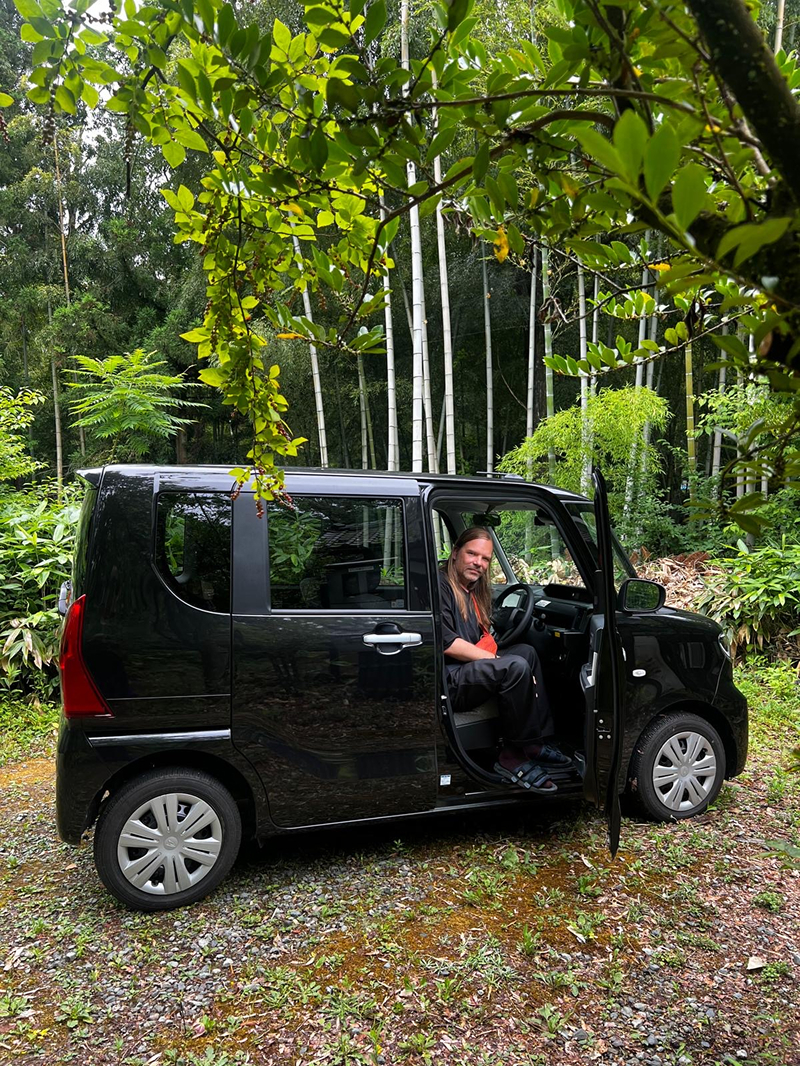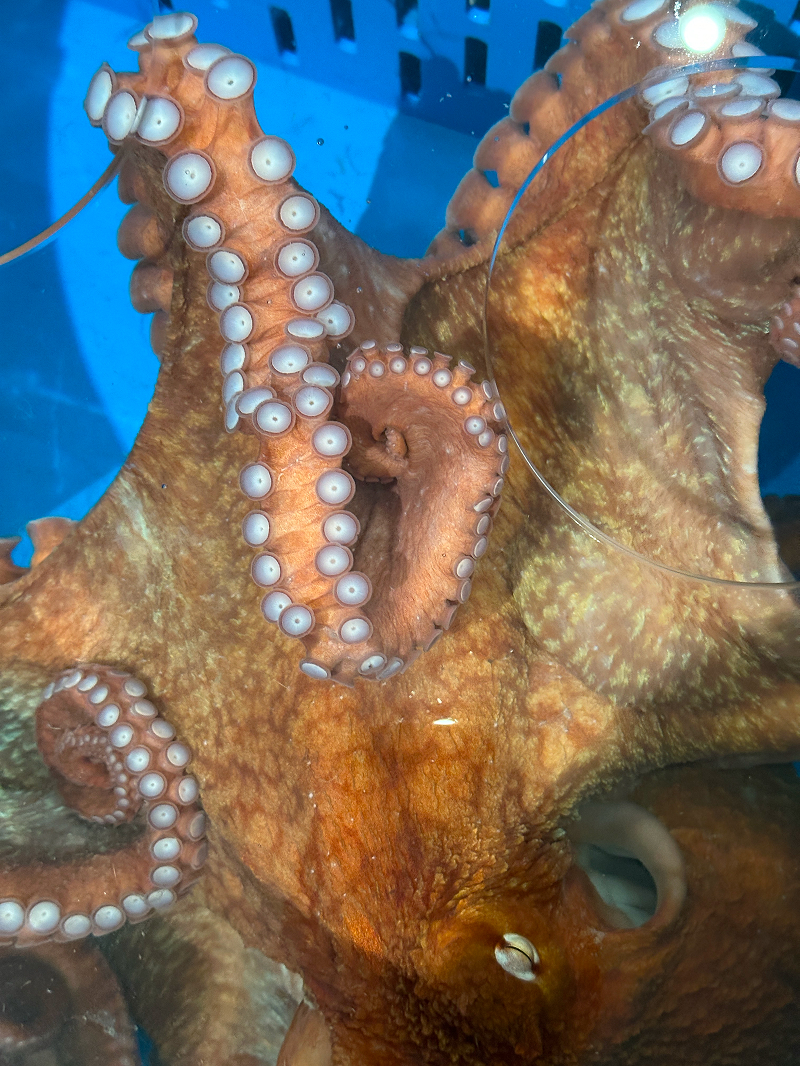Residency Fellows
2025
Dec. Essi Kausalainen + Mikko Kuorinki
Nov. Sara Blosseville + Victor Gogly
Oct. Eeva Rönkä + Jani Anders Purhonen
Sep. Charlotta Östlund
Aug. Anastasia Isakova
I spent August 2025 at Hamuro residency with my partner, and my stay was marked by quiet but profound experiences that will continue to shape my practice as a curator.
What I remember most is the presence of the forest around the beautiful residency house. The sound of insects created a meditative rhythm, a reminder of time moving slowly and of being part of something larger. I learned these were often suzumushi crickets, whose sounds mark autumn. This deep awareness of seasonality in Japan, woven into food, festivals, crafts, literature, gave me a new sense of how time shapes beauty and invited patience and presence.
The residency also taught me to see differently. At home my vision often narrows under deadlines and other people’s opinions, but in unfamiliar surroundings I began to slow down and observe without the urge to interpret. I noticed shapes, textures and details I might have overlooked. This revealed a quiet beauty in many things around, something I want to nurture as a person and working as a curator.
The concept of mingei, “the art of the people”, resonated strongly. In Japan, design and craft are part of daily life, carrying history and spirit as much as function. Visiting the Kutani Kiln Museum in Kaga deepened this reflection. Traditional crafts are not static heritage but living practices. I was also inspired by Keijiban, a tiny open-air gallery in Kanazawa that transforms a bulletin board into an exhibition space. It made me imagine similar micro-galleries in Helsinki, woven into the city’s everyday life.
My residency was full of modest but meaningful experiences, opening new ways of seeing and thinking. I am grateful to Shoji Kato, Toshinori Oka and Masateru Yoshimura for this opportunity and their generosity, and to the Scandinavia-Japan Sasakawa Foundation for the travel support.
・・・・・・・・・・・・
Anastasia Isakova is a curator with a background in exhibition studies and philology. She studied curating at the Academy of Fine Arts in Helsinki, where she completed the Praxis Master’s Programme in Exhibition Studies in 2018. Before that, she studied art criticism and Finno-Ugric philology and literature at St. Petersburg State University. Alongside her curatorial work, she has been part of the independent curator group P14, through which she curated exhibitions at the galleries Kallio Kunsthalle and Oksasenkatu 11 in Helsinki. From 2018 to 2025, she worked as a curator at Amos Rex Art Museum in Helsinki, where she was involved in developing and curating the museum’s exhibitions.
Jul. Jani Ruscica
The Hamuro air residency was for me intensely productive, not only on a very practical level, but also on an intellectual and spiritual level.
The vicinity of the Ceramic studio allowed me to develop objects from a series of new works tentatively titled ‘Phantom objects’. Under the guidance of Aaron Browne and Sayo Hashimoto, I was able to complete four new works in ceramics, all making use of different techniques and methodologies. Ceramics is something I haven’t worked with for over 25 years, my only experiences working with clay date back to high school and the extracurricular ceramics workshops that I took then. I was intrigued to discover the power of body memory, the distant familiarity of the material, all the remembering that took place. This was a deeply felt experience, and I am honestly amazed at what I managed to accomplish whilst working at the Kanaz Ceramic studio. The four ceramic objects are part of a larger body of works eventually encompassing more than 200 objects.
The studio space at Hamuro also allowed me to develop work on paper. What initially was meant to be a continuation or variation of current and existing works on rice paper took an unexpected turn, I believe much thanks to local stimuli, something seen and experienced whilst travelling around Japan prior to arriving at Hamuro. So instead of printing I ended up making the new works on rice paper with frottage technique. Similarly indexical in nature as printing, frottage consists of rubbing the paper with color, and at Hamuro I chose to work with dry pastel. Just like my previous print work, the 1:1 scale seemed important, I want my prints, and now my frottages, to maintain an indexical and 1:1 relationship to the thing they are a trace of, a ghostly imprint of. The resulting works (part of a series I am continuing in my studio in Helsinki, and will later exhibit at Galerie Anhava in an upcoming exhibition in January 2027) were made with found objects or detritus, locally sourced from the beach, from the Hamuro house, from the forest surrounding the house, etc. This to me is important, as this way the prints function much like photography, in their ability to trace and record not only time, but also material substance/presence.
Beyond what I practically made, the residency was also an important period to process future work, namely a suite of portrait videos involving a butoh dancer. Whilst in Tokyo I managed to contact the Kazuo Ohno Foundation and get access to material from their archives, order books, etc. Ohno, being a seminal figure in the development of Butoh, and someone whose work I deeply admire, seems like an important figure to study more in-depth while preparing this new video work. The opportunity to travel to Japan, for the first time in my life, certainly gave more depth to this research.
Needless to say, the residency, as usually is the case, also facilitated an intense time to see and experience a wealth of things, a lot of which also seemingly unrelated to any specific work. So influential were not only museums, spaces, places, events, but also an innumerable amount of other things that will surely have a huge impact on my thinking and making beyond the rational and conscious.
Jun. Sini Pelkki
May. Arttu Merimaa + Miina Hujala
Mar. Apr. Mayumi Niiranen-Hisatomi
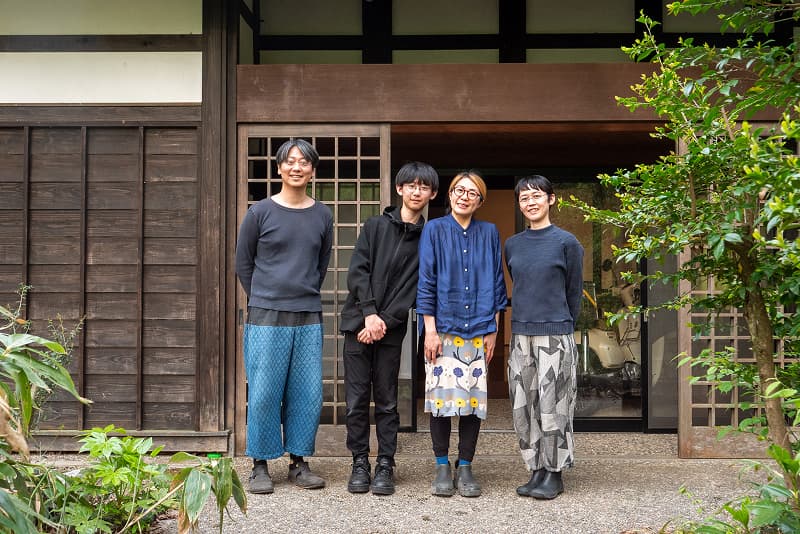
Looking Back on My days in Hamuro / June 26, 2025
First of all, I am Japanese, born and raised in Japan, and I have been living in Finland since 2008. When you go to a foreign country you have never visited, there is first the overwhelming presence of the large subject called “the country” or “the nation.” But since I am Japanese, naturally there was no sense of foreignness during my stay at Hamuro, so my attention was drawn instead—quite naturally—to the differences from the place where I grew up, Kobe; in other words, to the locality of the region. Above all, what I could not help but feel first during my stay at Hamuro was the presence of Sumiko Katō.
Hamuro felt more like a living space than a typical artist residency. It had only one small workroom where it felt acceptable to make a mess. Inside that small space, there were fabrics, dyeing materials, books, pots, and other things Sumiko Katō had left behind. Observing all the objects she would likely never use again was the starting point of my residency. I felt as though I was also looking at a reality that will probably come to me one day. Being surrounded by objects and continually materializing concepts—and seeing what remains when one can no longer work on producing physical artworks—felt like catching a glimpse of my own future while being in that small room. It was a time that overlapped with the questions I am always asking myself about how to deal with all the objects I make and use.
That said, I was determined to use this two-month residency fully, so I couldn’t allow myself to remain only sentimental. Almost as soon as I arrived, I began working. My first attempt was clear: to explore how to preserve the shapes and colors of plants around Hamuro on fabric without using metal mordants.
For example, this process required rice bran, so I started by asking a ceramics teacher, searching on Google Maps, and then going out on my Super Cub scooter to find some. During the residency, I kept repeating the cycle of asking, observing, researching, collecting, and transferring the shapes and colors of plants onto fabric—trying different methods of mordant dyeing.
I spent time observing the garden at Hamuro, watching the seasons shift, collecting plants, and perceiving their forms and colors on fabric. Later, I had the chance to meet people who are preserving and recognizing the Mokko-sashi culture, and through this, I was fortunate to meet Miwa Ishimori, a young ama, sea diver. Through this connection, the scope of my work expanded significantly—specifically to encountering seaweed.
Where I currently live in Kajaani, Finland, is inland, so I have no access to seaweed. Precisely because of that, I was determined to work on seaweed printing while I was in Japan.
To be honest, I feel I gained so much from this residency that it’s nearly impossible to summarize. If I were to name a few things, words like “ways of preserving culture,” “ways of preserving artworks,” “Japan’s endemic species,” and “the inseparability of body and land in artistic practice” come to mind.
It may feel like a sudden shift after writing so much about my work, but perhaps the most memorable part of my stay at Hamuro was meeting the Oka family and Ms. Yoshimura, who looked after me. They were such wonderful people—how grateful I am. And to the Jizō statue in Hamuro, I offer my heartfelt thanks.
Mayumi Niiranen-Hisatomi
Feb. Niina Tervo

The raven jumps on the thick branches of a dead tree and drips snow, and from there under the branches of a spruce, from there to the upper branches of an unknown bush-like tree and from there to the ground. Back up to the trunk of a small fallen tree, carefully poking the trunk with its beak, exploring, perhaps eating. The movements are controlled and soft, questioning.
white fades slowly from the left, it begins to shine more brightly, water drips in heavy drops, the transformation has no clear boundary
A red light reflects and flashes from a branch of a pine-like tree, although it may be more of a thuja. The dripping of the melting water droplets accelerate, but the leafless trees hold on to them. It rains colors inside the forest. I’ve never seen light reflected like this before.
The blue color of the lower branch is continuous.
stretching water feels lazy and ready to sink into the soil
The sun and water seem to be friends? The sun and the earth seem to be friends. Water and land seem to be friends. Air seems to be no one’s friend, but later with water and animals.
Spring
2024
Nov. Dec. Elina Vainio + Matti Kunttu
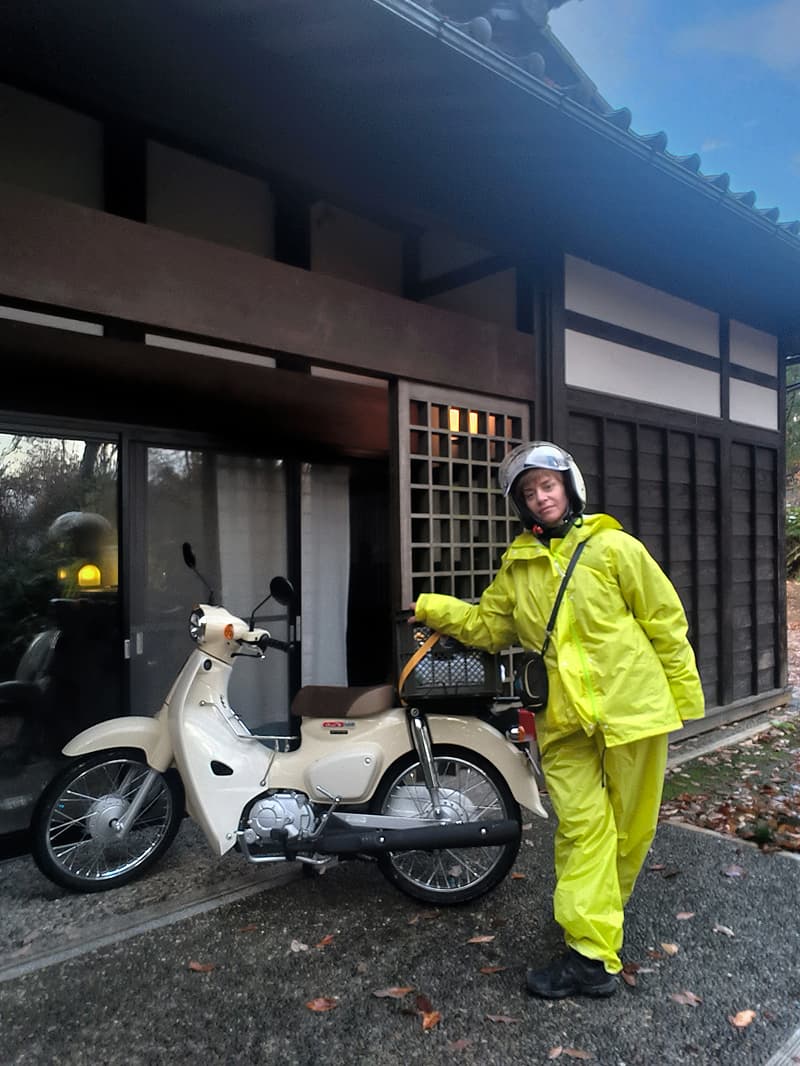
ElinaVainio
The six weeks I spent at Hamuro were characterised by a certain kind of ease in terms of how new work ideas kept surfacing and how I went about experimenting especially with washi papers, a variety of starch pastes, natural pigments and corrugated surfaces.
Now looking back, I associate this ease of working to have had something to do with the independent, artist-run character of this micro residency initiative, where I didn’t feel any explicit or implicit expectations related to production, networking or visibility that come with the more institutional residencies. I also enjoyed becoming a temporary student of the Kanazu Sosaku no Mori pottery classes and learning from instructor Aaron Brown.
I want to thank Shoji Kato, Toshinori Oka and Katsunobu Yaguchi for opening doors to many places I wouldn’t have accessed otherwise. I would also like to extend my thanks to the Finnish Cultural Foundation for the Mobility Grant and the Kone Foundation for supporting my work.
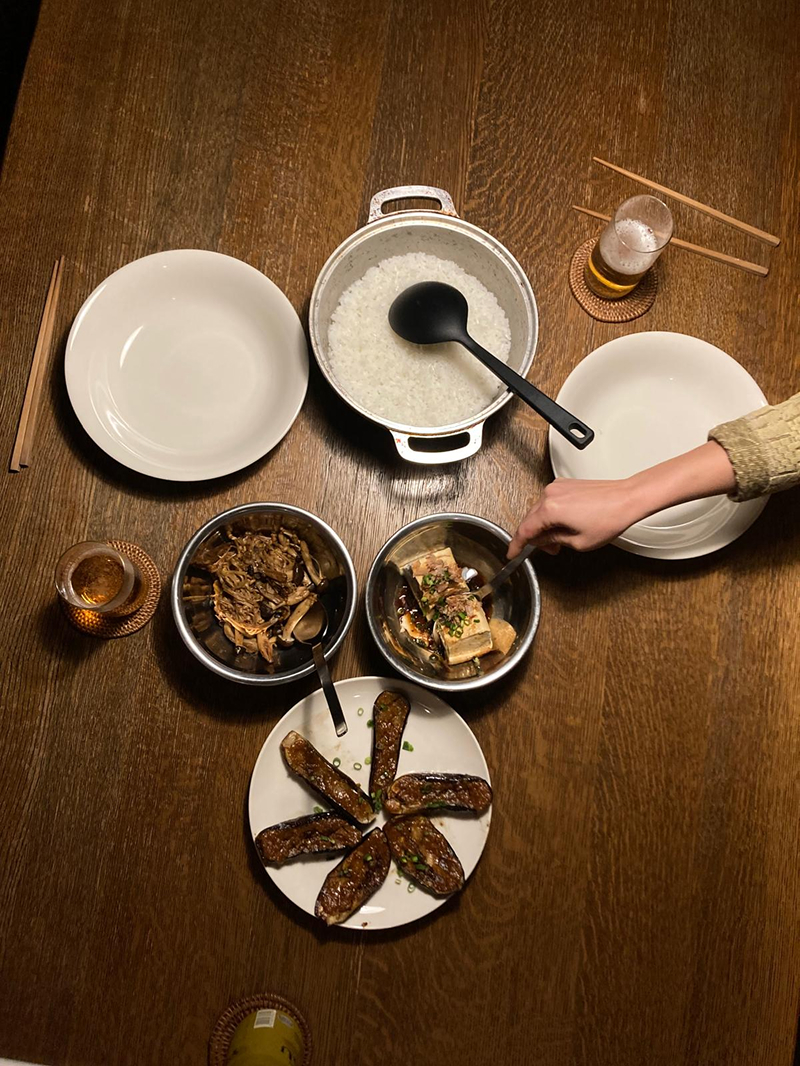
Matti Kunttu
Staying at Hamuro meant settling into a simple rhythm that mostly consisted of going for walks, working, getting groceries and cooking. What a rare treat!
Oct. Mikko Kuorinki
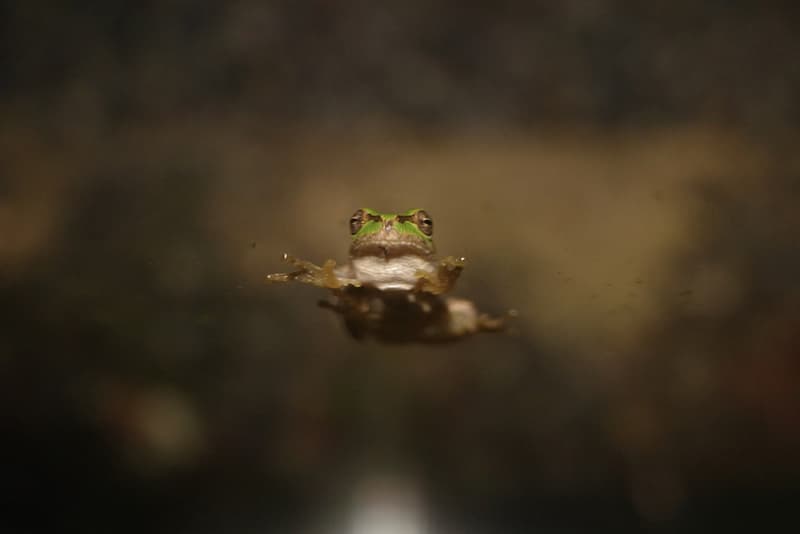
light lays on the leaf
the leaf holds the light
the light plays with the wind
with the hole on the leaf
when i wake up drooling on the floor
a praying mantis carefully
explores the surface of insect net right in front of my eyes
dust settles and we wait for the melody to signal the beginning or the end
air is let in
screeches of various beings
closer and further
commuters
i can’t help but make an image out of it again
Sep. Marja Ahti

During my one week residency at Hamuro, I spent my time recording the landscape in the immediate vicinity of the house during different time periods of the day and night. It was September, the active season of the suzumushi cricket, whose loud, constant chiming set the mood throughout the week, accompanied by sounds from other birds, insects, occasional traffic and nearby work sites, creating a static mood, yet changing subtly with the rising and setting of the sun, the waking and sleep rhythms of the beings in the vicinity and on a distance. The recording sessions were also occasions for practicing listening and sitting quietly and attentively through durational recordings.
I made two performances in Fukui during the residency — both curated by Shoji Kato. The first was in the beautiful pavilion of Yokokan garden in Fukui city. The event was titled ”Setting and rising” and took place on the threshold of dusk, with the waning light as a backdrop to the event. The sounds reflected this transition — opening with a bright and percussive composition that gradually develops into a deeper, meditative mood based on slow pulsating waves and delicate textures. On the occasion of the autumn full moon, the second event “Tsuki”, I performed a few recent electronic pieces related to nocturnal themes alongside another version of my current piece in progress “Touch This Fragrant Surface of Earth”, as an offering to the moon.
Aug. Ki Nurmenniemi
Jun. Jul. Tuomas A. Laitinen + Emilija Škarnulytė
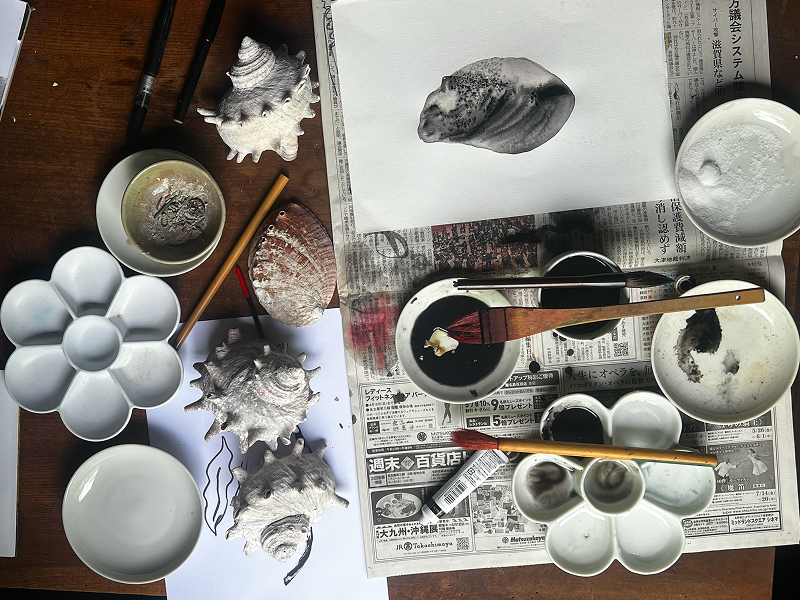
Emilija Škarnulytė
Japanese Turban Shell (Sazae / サザエ)
&
Abalone shell (Awabi/アワビ)
ink drawing on paper
2024 June Hamuro

